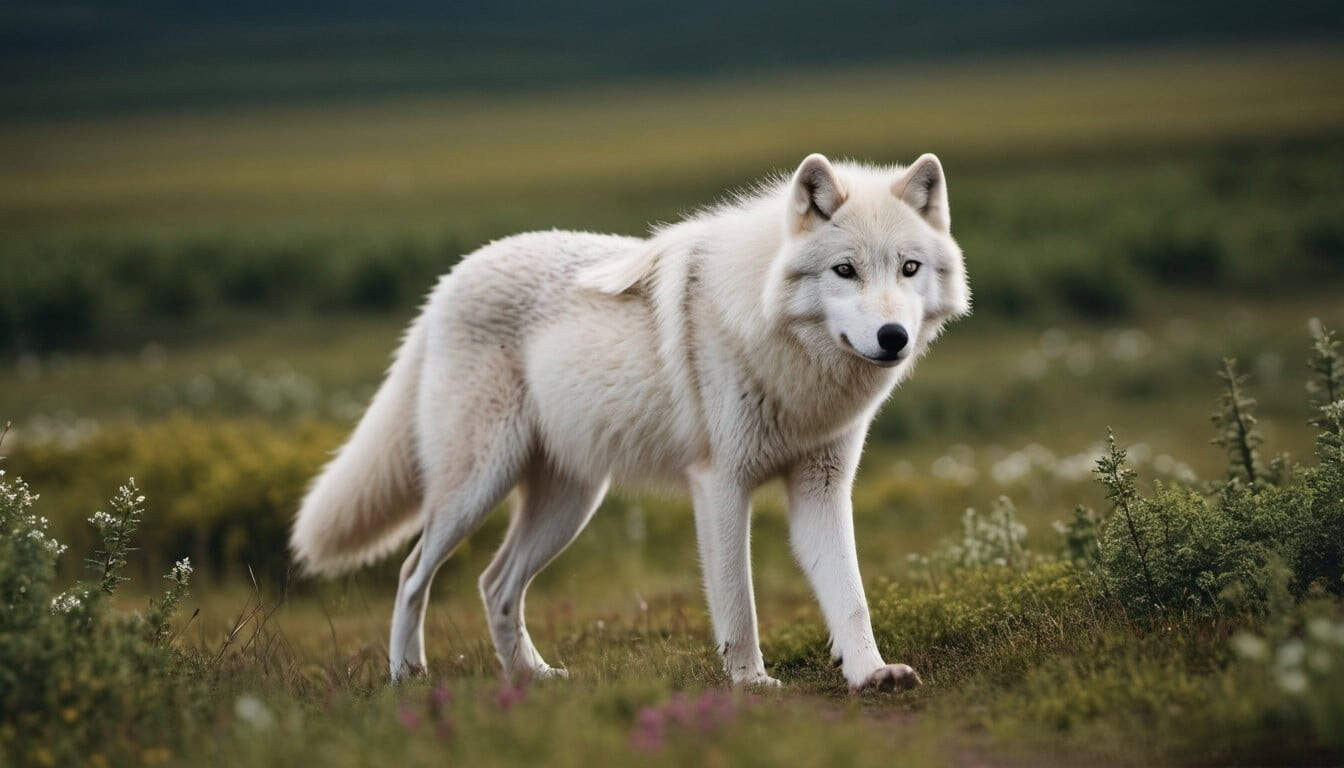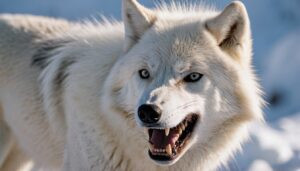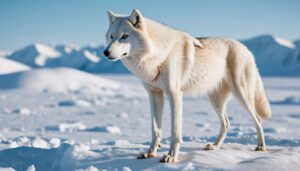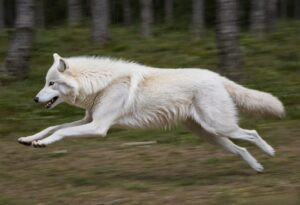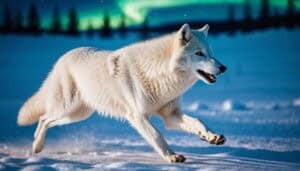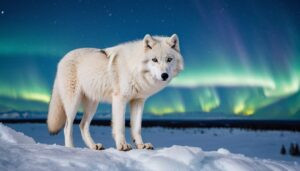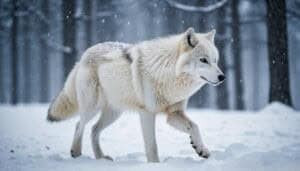Introduction
Understanding the average stride length of Arctic wolves provides valuable insight into their movement, hunting strategies, and adaptation to their harsh environment
This article delves into the factors influencing their stride length, methods used for measurement, comparisons with other wolf species, and the impact on their daily activities and hunting efficiency. By exploring these aspects, we gain a comprehensive view of how stride length plays a crucial role in the life of an Arctic wolf
Factors Influencing the Stride Length of Arctic Wolves
Understanding the factors that influence the stride length of Arctic wolves is essential to comprehend their movement patterns, hunting efficiency, and adaptation to the Arctic environment
Various elements, including environmental conditions and physical characteristics, play a significant role in determining the stride length of these remarkable animals
Environmental Factors
The harsh Arctic environment profoundly affects the stride length of Arctic wolves
These wolves live in some of the most extreme conditions on Earth, with temperatures often dropping below -30°F and extensive snow cover for most of the year. These environmental conditions necessitate specific adaptations in their locomotion
One key environmental factor is the depth and consistency of snow. Deep snow can hinder movement, forcing wolves to lift their legs higher and extend their stride length to navigate efficiently
Research has shown that Arctic wolves develop a more elongated stride in deep snow to reduce the frequency of steps and conserve energy. In contrast, on hard-packed snow or ice, their stride length becomes shorter and quicker to maintain stability and speed
Temperature also plays a role. In colder temperatures, the muscles of Arctic wolves can become stiffer, potentially reducing their stride length. Conversely, milder temperatures might allow for a more relaxed and extended stride
These adaptations help Arctic wolves maintain their hunting efficiency and overall mobility regardless of the environmental challenges they face
Physical Characteristics
The physical characteristics of Arctic wolves significantly influence their stride length
These wolves are built for endurance and power, which is reflected in their muscular build and limb structure. On average, an adult Arctic wolf stands about 2.5 to 3 feet at the shoulder and can weigh between 70 to 175 pounds, with males generally being larger than females
The limb length and muscle composition are crucial determinants of stride length. Arctic wolves have long legs relative to their body size, which helps them cover more ground with each stride. The robust muscles in their hind legs provide the necessary thrust to propel them forward efficiently
Additionally, their wide, padded paws distribute their weight more evenly on the snow, preventing them from sinking too deeply and allowing for a smoother stride
Age and health also impact stride length. Younger wolves and those in peak physical condition tend to have a longer stride due to their vitality and muscle strength. Older wolves or those suffering from injuries or health issues may exhibit a shorter stride as their mobility decreases
The combination of environmental factors and physical characteristics creates a complex interplay that determines the stride length of Arctic wolves. These adaptations are crucial for their survival, enabling them to hunt effectively, traverse their vast territories, and cope with the ever-changing Arctic landscape
Measuring the Stride Length of Arctic Wolves
To understand the movement and behavior of Arctic wolves, accurate measurement of their stride length is essential. Various methods and tools are employed to gather precise data, despite the challenges posed by the harsh Arctic environment
Methods and Tools
Several methods are utilized to measure the stride length of Arctic wolves
Traditional techniques involve tracking wolves in the snow, where their footprints can be observed and measured directly. Researchers use tools like measuring tapes or rulers to measure the distance between consecutive footprints, providing data on stride length
This method, while straightforward, requires careful attention to ensure accuracy, as snow conditions can alter the clarity of the tracks
Modern technology has introduced more sophisticated tools for measuring stride length. GPS collars equipped with motion sensors are commonly used to track wolves’ movements over large distances. These collars provide detailed data on the wolves’ location, speed, and movement patterns, allowing researchers to calculate stride length based on the distance covered and the number of steps taken
This method offers a high level of accuracy and can be used in various environmental conditions without relying on visible tracks in the snow
Another advanced tool is the use of trail cameras equipped with motion detectors. These cameras are strategically placed in areas frequented by wolves, capturing images and videos of their movements. By analyzing the footage, researchers can measure stride length and observe the wolves’ behavior in different contexts
This method is non-invasive and provides valuable insights without disturbing the animals
Accuracy and Challenges
While modern tools have improved the accuracy of measuring stride length, several challenges remain. One significant challenge is the variability in snow conditions. Deep, powdery snow can obscure tracks, making it difficult to obtain precise measurements
Conversely, hard-packed or icy snow can alter the wolves’ natural stride, leading to potential inaccuracies. Researchers must account for these variations and adjust their measurements accordingly
Another challenge is the behavior of the wolves themselves. Arctic wolves cover vast territories, often moving through remote and inaccessible areas. Tracking their movements continuously can be logistically challenging and resource-intensive
GPS collars and trail cameras help mitigate this issue, but ensuring the devices remain functional in extreme cold and harsh weather conditions requires careful planning and maintenance
Despite these challenges, researchers have made significant strides in understanding the stride length of Arctic wolves. Studies have shown that the average stride length of an Arctic wolf ranges from 50 to 70 inches, depending on various factors such as age, sex, and environmental conditions
This data is crucial for understanding their hunting strategies, energy expenditure, and overall adaptation to the Arctic ecosystem
Continued advancements in technology and methodology will further enhance our ability to measure and understand the stride length of Arctic wolves, providing deeper insights into their behavior and ecology
Comparison with Other Wolves
Comparing the stride length of Arctic wolves with other wolf species provides valuable insights into their unique adaptations and behaviors
This section explores how Arctic wolves differ from their grey wolf counterparts and other canines, highlighting the evolutionary and environmental factors that contribute to these differences
Grey Wolves vs. Arctic Wolves
Grey wolves (Canis lupus) and Arctic wolves (Canis lupus arctos) share a common ancestry but have adapted to different environments, leading to variations in their stride length and movement patterns. Grey wolves typically inhabit forests, grasslands, and mountainous regions, where the terrain varies significantly compared to the Arctic tundra
One notable difference is the stride length. Grey wolves generally have a shorter stride length than Arctic wolves. The average stride length of a grey wolf ranges from 30 to 40 inches, while Arctic wolves have an average stride length of 50 to 70 inches
This difference is primarily due to the need for Arctic wolves to cover larger distances efficiently in their vast, open habitat. The longer stride helps them conserve energy and move quickly across snow-covered landscapes, essential for hunting and territorial patrols
Grey wolves, on the other hand, navigate more varied and sometimes denser terrains, where a shorter, more agile stride is advantageous
Their environments often require quick maneuvers around obstacles such as trees and rocks, making a shorter stride more practical. This adaptation enhances their ability to hunt smaller prey and navigate their diverse habitats
Additionally, the physical build of grey wolves contributes to their shorter stride length. They tend to have more robust and shorter limbs compared to the elongated limbs of Arctic wolves
This physical trait supports their agility and strength in diverse terrains but limits the extension of their stride compared to their Arctic counterparts
Other Canine Comparisons
Beyond grey wolves, comparing Arctic wolves to other canines, such as coyotes and domestic dogs, reveals further distinctions in stride length and movement adaptations
Coyotes (Canis latrans) have an average stride length of approximately 24 to 30 inches, significantly shorter than both grey wolves and Arctic wolves. This shorter stride suits their smaller size and more varied habitats, including deserts, forests, and urban areas
Coyotes are known for their agility and ability to quickly change direction, making a shorter stride length beneficial for their survival and hunting strategies
Domestic dogs (Canis lupus familiaris) exhibit a wide range of stride lengths depending on their breed, size, and physical condition. For example, larger breeds like the Great Dane or the Greyhound can have stride lengths similar to wolves, while smaller breeds like the Chihuahua have much shorter strides
The variability in domestic dogs’ stride lengths reflects their diverse breeding purposes and environments, unlike the specific adaptations seen in wild canines like Arctic wolves
These comparisons underscore the unique adaptations of Arctic wolves to their environment. Their longer stride length is a specialized trait that supports their survival in the harsh Arctic conditions, distinguishing them from other wolves and canines adapted to different habitats and ecological niches
Understanding these differences not only highlights the evolutionary pathways of these species but also provides insights into their behavior, ecology, and conservation needs. By examining the stride lengths and movement patterns of Arctic wolves and other canines, researchers can better appreciate the diverse strategies these animals employ to thrive in their respective environments
Impact of Stride Length on Hunting Efficiency and Daily Activities
The stride length of Arctic wolves significantly affects their hunting efficiency and daily activities. This section explores how their stride length enhances their predatory strategies, influences energy expenditure, and shapes their movement patterns and territorial behavior
Predatory Strategies
Arctic wolves are highly efficient predators, and their stride length plays a crucial role in their hunting strategies
The extended stride length of 50 to 70 inches allows them to cover large distances quickly, essential for locating and pursuing prey in the vast Arctic tundra. Their primary prey includes muskoxen, Arctic hares, and caribou, which are also adapted to the harsh environment and can move swiftly across the snow
The ability to take longer strides helps Arctic wolves maintain a steady, energy-efficient pace while tracking or chasing prey. This is particularly important during long hunts where stamina and endurance are vital. By covering more ground with each step, they reduce the number of steps needed, conserving energy and minimizing fatigue
This efficiency is crucial in the Arctic, where energy conservation can mean the difference between survival and starvation
Additionally, the long stride length aids in the initial sprint to catch prey. When Arctic wolves identify a target, they can quickly close the distance with powerful, long strides, increasing their chances of a successful capture. This combination of endurance and explosive speed is a key component of their predatory success
Energy Expenditure
The stride length of Arctic wolves also impacts their energy expenditure. In the cold Arctic environment, conserving energy is paramount. A longer stride length reduces the frequency of steps, which can lower the overall energy expenditure during movement
This efficiency is particularly beneficial during the winter months when food can be scarce, and wolves must travel greater distances to find prey
Studies have shown that the energy cost of locomotion in animals is influenced by stride length and frequency. By optimizing their stride length, Arctic wolves can maintain a balance between speed and energy efficiency. This adaptation is critical for their survival, as it allows them to cover vast territories in search of food while minimizing the energy spent on locomotion
Furthermore, the physical adaptations that support a longer stride, such as strong, muscular limbs and wide, padded paws, also contribute to energy efficiency. These traits enable Arctic wolves to move smoothly across snow and ice, reducing the resistance and effort required for each step
Movement Patterns
The stride length of Arctic wolves influences their movement patterns, particularly in terms of territorial behavior and daily activities
Arctic wolves have large home ranges, often covering territories that span hundreds of square miles. A longer stride length allows them to patrol these areas more efficiently, marking their territory and monitoring for intruders or potential threats
During daily activities, such as traveling between hunting grounds or returning to their den, a longer stride length enables Arctic wolves to move quickly and efficiently. This is crucial in the Arctic, where environmental conditions can change rapidly, and the ability to move swiftly can impact their safety and access to resources
Additionally, the stride length of Arctic wolves affects their social interactions and group dynamics. Wolves often travel in packs, and a synchronized stride length ensures that the pack moves cohesively and maintains its structure. This coordination is essential for successful hunting and territorial defense
Territorial Behavior
Territorial behavior in Arctic wolves is closely linked to their stride length. By covering large distances efficiently, they can patrol their territory and maintain their dominance over a defined area. This territoriality is crucial for securing food resources and preventing conflicts with neighboring wolf packs
A longer stride length allows Arctic wolves to leave scent marks and visual markers over a wider area, reinforcing their presence and deterring potential intruders. This behavior not only secures their territory but also plays a role in their reproductive success by ensuring access to mating opportunities and den sites
The stride length of Arctic wolves is a fundamental aspect of their hunting efficiency, energy expenditure, movement patterns, and territorial behavior. These adaptations enable them to thrive in the challenging Arctic environment, highlighting the intricate relationship between physical traits and ecological success
Conclusion
The study of Arctic wolves and their stride length provides a fascinating glimpse into how these remarkable animals have adapted to one of the harshest environments on Earth
From the factors influencing their stride length, such as environmental conditions and physical characteristics, to the methods used to measure this crucial aspect of their movement, researchers gain valuable insights into their behavior and survival strategies. Comparing the stride length of Arctic wolves with other wolves and canines further underscores the unique adaptations that set them apart
Understanding the impact of stride length on hunting efficiency and daily activities highlights how crucial this physical trait is for energy conservation, predatory success, and territorial behavior
The extended stride length allows Arctic wolves to navigate their expansive habitats efficiently, ensuring they can hunt effectively and patrol their territories with minimal energy expenditure. These adaptations are vital for their survival in the Arctic’s extreme conditions
The comprehensive exploration of these topics not only enhances our knowledge of Arctic wolves but also contributes to broader ecological and conservation efforts. By understanding the intricacies of their movement and behavior, conservationists can develop more effective strategies to protect these incredible animals and their habitats
